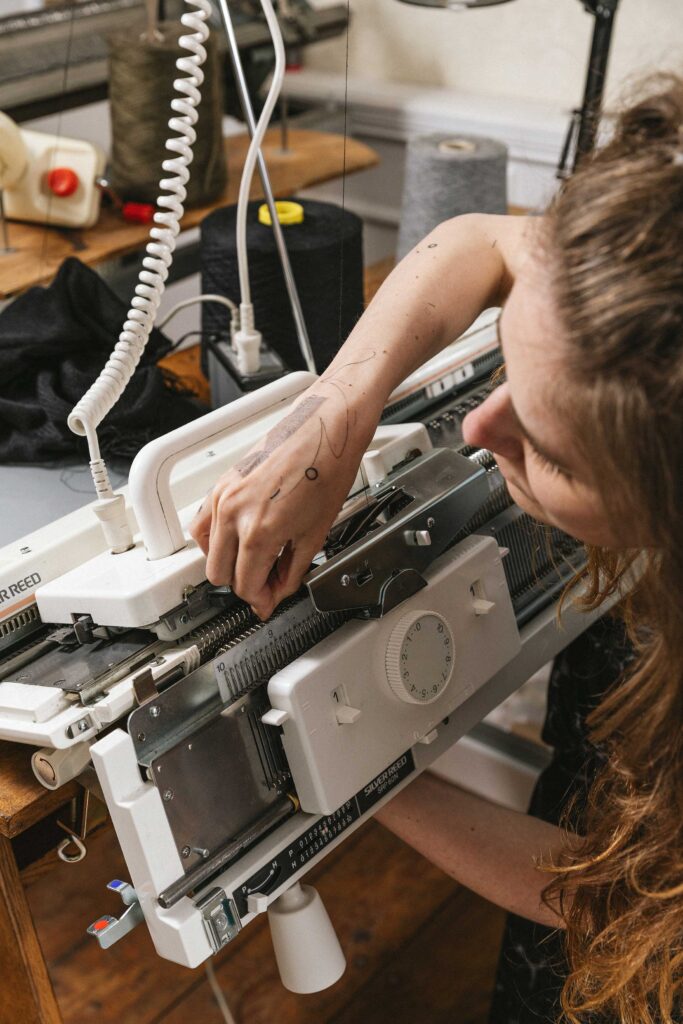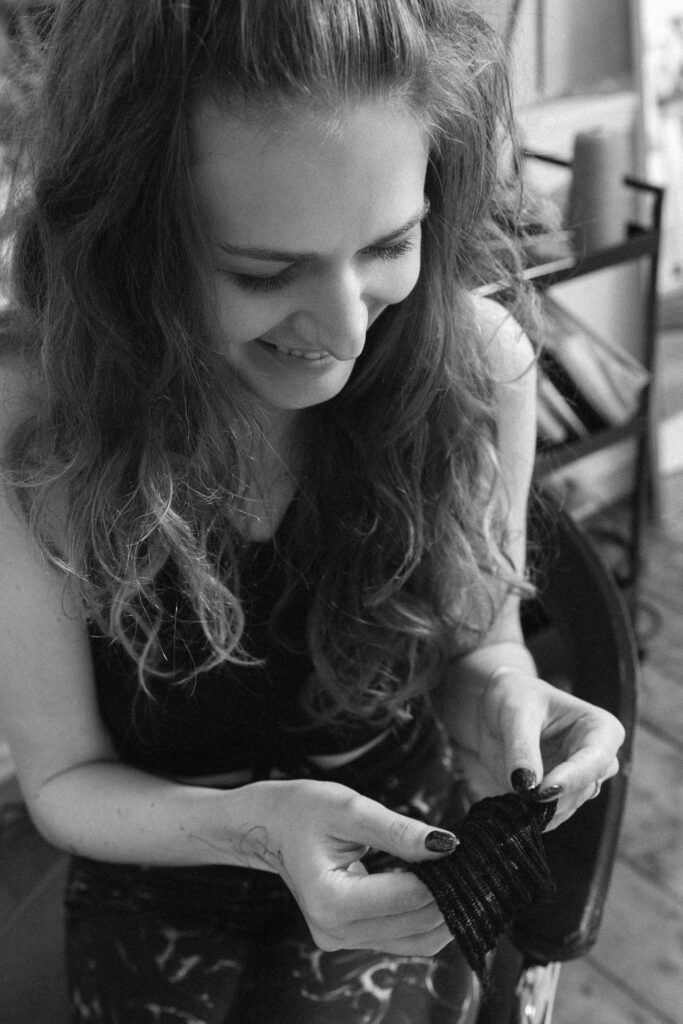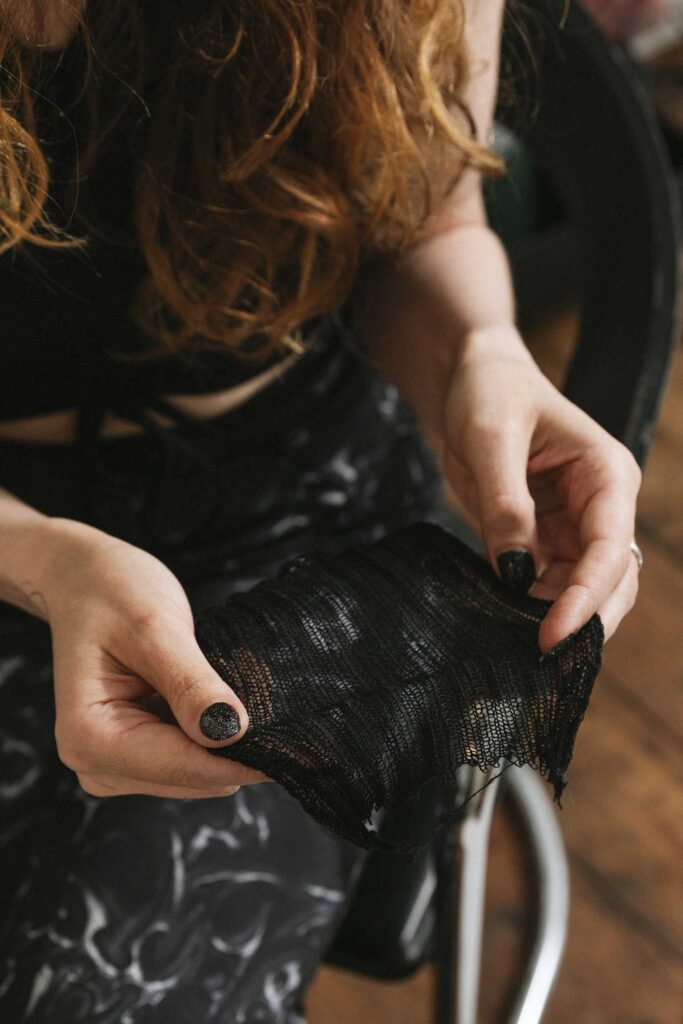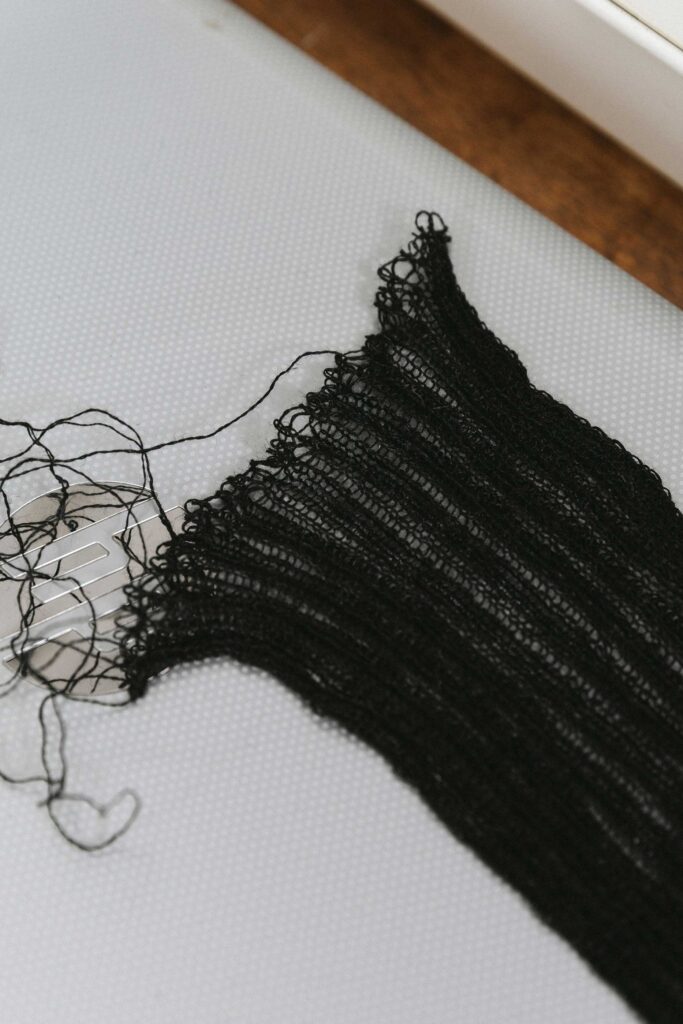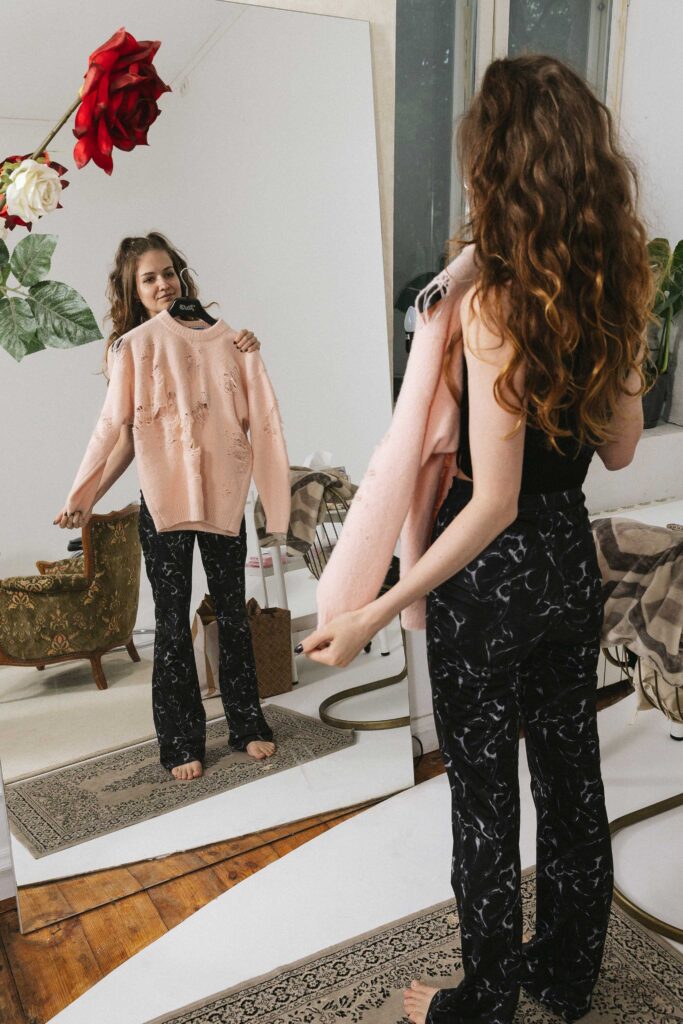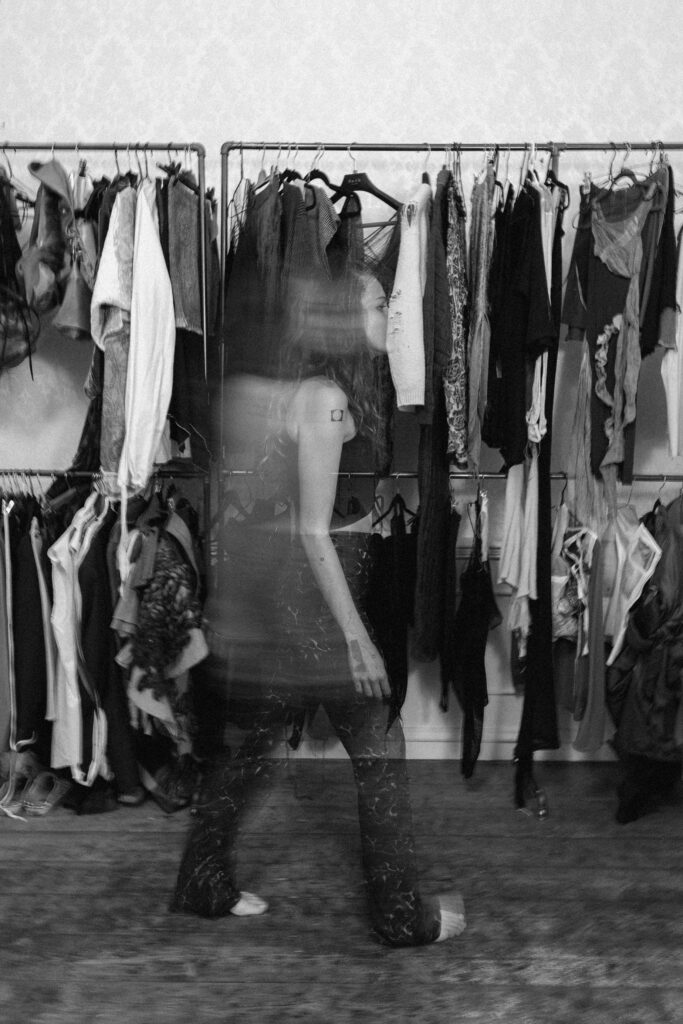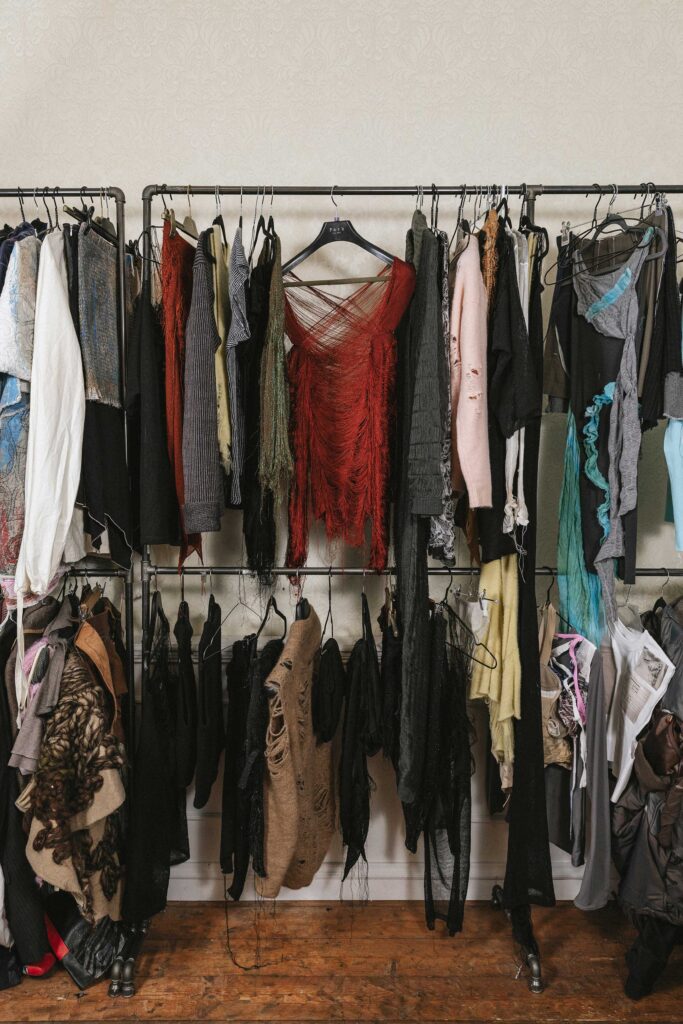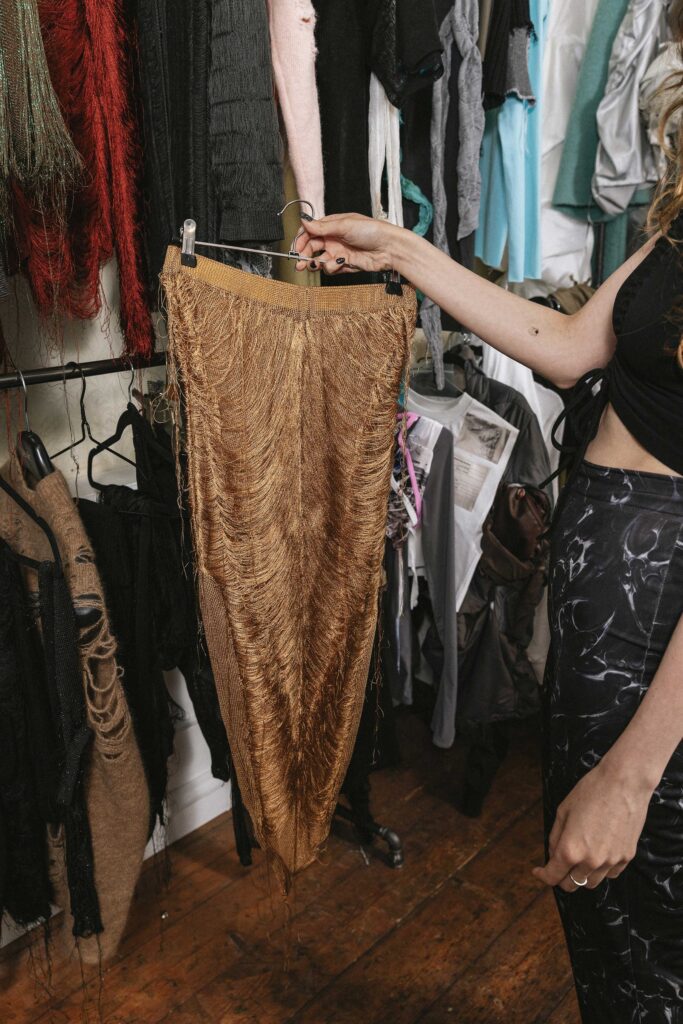“I came to this building last March with my studio mates. I love the spaciousness and the special spirit of this place. I enjoy that the sea is right here. I also appreciate the creative environment – it’s not sterile, but liberating. I think it’s wonderful to share a studio with someone because you can exchange ideas,” says Liisa.

Liisa Kanemägi: Excentrically Chic Knitwear
13.03.2025
The studio of knitwear artist Liisa Kanemägi is located at Kopli Lines, in a nearly century-old limestone building. Formerly used as the Shipyard Hospital and the university’s chemistry building, the structure now houses a number of creative individuals, and the building is called Signature House.
The journey to knitwear art
Liisa learned to knit in her childhood under the guidance of her grandmother. “I knitted little sweaters for Barbies. I also enjoyed knitting in school’s handicraft lessons. In 2015, I was introduced to machine knitting for the first time at the Tartu Art College, and I’ve been a big fan ever since. After that, I studied fashion design at the Estonian Academy of Arts (EKA) and worked on my projects, which I linked with knitwear art.”
At Tartu Art College, Liisa learned to create things with her hands from various materials. At EKA, she learned to conceptualize them and infuse emotions into her creations. It was at EKA that Liisa developed her own signature technique. “While studying at EKA, I realized what I love doing most – knitting. Now, I see that I will stick with it. I enjoy being able to experiment a lot. I can put a piece of myself into the knitwear.”
At the same time, she acknowledges that the technique is challenging, and there are moments of both laughter and tears. “When knitting on a hand machine, the item can suddenly fall off, and fixing it takes a lot of time. Now, I’ve learned to understand the machine better, and at least I can put the piece back on the machine. But before, I would just start over. And that could be a whole day’s work that went wrong,” Liisa describes.
Creative work and brand
Liisa mostly knits tops, sweaters, and shirts. She primarily uses linen, wool and silk as materials. “These materials are body-friendly, yet they feel luxurious and expensive. Linen is my special favorite because it’s a strong material. Black linen even feels a bit graphic on the body. It’s a material with character, and it aligns with the feeling of my brand.”
According to Liisa, her brand is a bit rebellious and challenges the rules of classic beauty and elegance. At the same time, it is also mysterious and curious. “Recently, I came up with a phrase for myself: ‘eccentrically chic.’ I also make things that branch out, meaning they change a bit over time. I enjoy playing with meaning, so that things wouldn’t just be ‘finished’ or ‘broken,’ but they could ‘live on,'” she reflects.
Wearable products
Liisa’s clients have mostly been women, although men have also purchased her creations. “My client is someone who values the emotional worth of clothing over fast fashion. They are willing to pay a little more. They also create their own aesthetic, and for them, self-expression is more important than the practical side of clothing. I think they are also interested in art and design,” Liisa reflects.
The items that have sold the most are the branching sweaters, an idea that came to Liisa during her studies at EKA. “I wanted to create something that seemed worn and could branch out, change… During one course at EKA, I discovered a water-soluble material and started experimenting with it. Later, I realized that branching was a very interesting topic, and I wrote my thesis about it (‘Knitted Transience – The Dialogue Between Knitted Loops and the Body’).”
To create the branching sweaters, the artist uses her own signature technique. “There is a logic behind creating these holes; the locations of the holes are known to me before I start making them. I transfer sweat patterns onto the holes. My exhibition sweaters were made from water-soluble materials. They were worn by real people, and sweat patterns formed on them. Then I scanned these patterns and now use them in wearable pieces,” Liisa explains.
In her master’s thesis, Liisa also pointed out that sustainability today is very much focused on products that should last a long time. “This is a speculative work. I turned it around, asking, what if things were not ‘finished,’ but could ‘evolve further’ with us? Maybe then there wouldn’t be a right moment to give them up. At the same time, very long-lasting products could mean waste that never breaks down. Emotional and physical durability might not always be the same thing.”
Materials with soul
Liisa notes that, compared to the past, we no longer feel materials. “We have so many materials, but we know nothing about them. That’s where the sweat pattern idea came from, which would be connected to your body. The idea was to reconnect with the material you’re wearing. I played with the thought that the material could acquire intentional wear marks, memories. That ‘life’ could continue to shape the clothes. My master’s thesis was more of a philosophical reflection, not a research paper.”
Liisa’s great wish is for people to value their clothes and learn to repair them. “Somehow, in society, there’s this understanding that if something has a hole, it’s ruined. But it doesn’t actually mean that it’s trash; we just perceive it that way. Things could wear out with dignity or beauty. With character. That’s why I thought I could intentionally program wear marks into the items.”
From DIY to production
Liisa has found two manufacturers in Estonia and one in Lithuania to collaborate with, as knitting alone isn’t enough to get everything done. Right now, she is focused on developing the prototypes needed for production, which is a time-consuming process and requires compromises: “Maybe I’m too attached to my own ideas, which the manufacturers can’t fully execute. I haven’t yet reached the perfect prototype,” laughs Liisa.
At the same time, she believes that when creating her next collection, she will already have a better understanding of the manufacturers’ capabilities, and the process of creating prototypes will go more quickly.
Inspiration and motivation
Liisa is most inspired by the work process, experimentation, and testing. “When I sit down at the machine and start creating something, it’s the process of making, the textures formed through the cooperation of my hands and brain—that’s what inspires me. But inspiration can also come from everyday things. For example, recently I had a big ‘aha’ moment when I looked at my broken socks. Inspiration can come from anywhere, but I still need to touch and make something with my hands. For me, just sitting down and writing out a concept doesn’t work as well as actually creating something.”
Liisa finds motivation in simply reminding herself of how important the process is and trusting it. “Patience has definitely been the key for me. As an entrepreneur, you can’t expect quick and easy solutions. Sometimes I praise myself for it and remind myself that I’ve already walked this path, I’m still here, and I’m doing my thing.”
Liisa considers patience and determination to be her greatest success, which keeps her on track. “And the fact that I get to do what I love. That I have the opportunity. That I also have support in the form of a network.”
Liisa would like to participate more in exhibitions and performances. “I want my creations to be deeply intertwined with art as well. I think that would keep me creatively fresh. And of course, I want my brand to grow bigger – beyond Estonia. I want it to become my main source of income,” she shares.
Where is Estonian design heading?
Liisa happily notes that more and more creators are putting stories and emotions into their products. “I would like them to have enough clients and resources before they run out of energy. Unfortunately, as a designer, it’s not easy to make a living; money is always, unfortunately or fortunately, an issue. At the same time, I believe that there are more and more people who value the emotional worth of products. Products and design are becoming more long-lasting – fewer items, but more exciting ones!”



